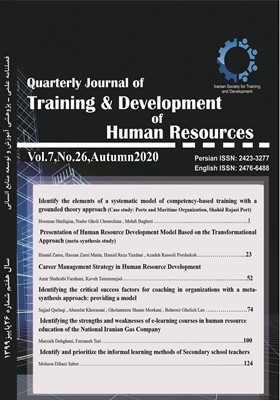-
-
List of Articles
-
Open Access Article
1 - Identify and prioritize the informal learning methods of Secondary school teachers
Mohsen Dibaei saber -
Open Access Article
2 - Presentation of Human Resource Development Model Based on the Transformational Approach (meta-synthesis study)
Hamid Zare Azadeh Rasouli porshokouh Hasan Zaree Matin Hamid Reza Yazdani -
Open Access Article
3 - Career Management Strategy in Human Resource Development
Amir Shahrabi Farahani Kaveh Teimoornejad -
Open Access Article
4 - identifying the critical success factors for coaching in organizations with a meta-synthesis approach: providing a model
Sajad Gharloghi Abasalt Khorasani Gholamreza Shams Moorkani Behrooz Ghelichlee -
Open Access Article
5 - Identifying the strengths and weaknesses of e-learning courses in human resource education of the National Iranian Gas Company
Marziyeh Dehghani Farzane Tari -
Open Access Article
6 - Identify the elements of a systematic model of competency-based training with a grounded theory approach (Case study: Ports and Maritime Organization, Shahid Rajaee Port)
Homan Shafighian Nadergholi GHourchian Mehdi Bagheri
-
The rights to this website are owned by the Raimag Press Management System.
Copyright © 2017-2025







